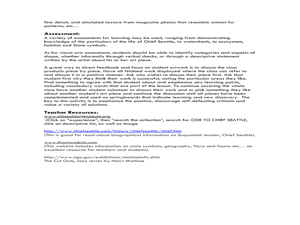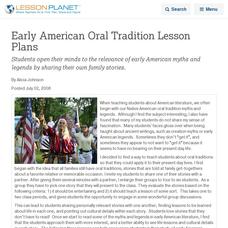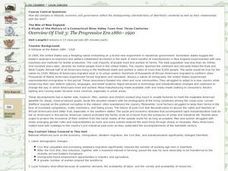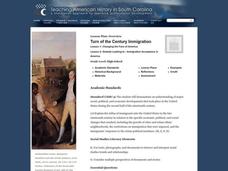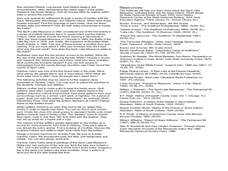Curated OER
Cut Outs: Shapes and Symbols
Students create collages based on Juan Quick-to-See Smith's "Ode to Chief Seattle." In this shapes, symbols and Native American lesson, students examine the "Ode to Chief Seattle" and Henri Matisse's cutout work. Students design their...
NET Foundation for Television
1850-1874 The Kansas-Nebraska Act
How the Kansas-Nebraska Act created Bleeding Kansas is complicated—until scholars research and examine documents from the time. After completing activities that include mapping, photo, document analysis, and discussion, learners...
Curated OER
Salt of the Earth: A Caddo Industry in Arkansas
Middle schoolers explore the history of the Caddo Salt Industry found in Arkansas. Along with learning about how salt deposits formed in Arkansas, learners study the process of salt production and how valuable salt is as a natural...
Center for History Education
Transforming the West: Did the Reality Match the Expectations for Kansas Homesteaders?
They expected good soil and hearty crops ... but they found buffalo chips and grasshopper plagues. Using an advertisement encouraging famers to go west, budding historians examine primary sources including letters, photographs, and...
Curated OER
Ready-Set-Go-Whoa!
The Apaches: People of the Southwest offers readers a chance to employ the “Ready-Set-Go-Whoa!” strategy (an adaptation of the KWL) to test what they know and summarize what they learn as they read Jennifer Fleischner’s nonfiction...
Curated OER
Fertilizers, Pesticides and Human Health- American Lessons
Students explore migration and why people move. They explore the movement of native populations. Students explore the economy as an factor in migration. They discuss the exploitation of the migrant worker.
Curated OER
What Counts as History?
Eighth graders explore the question "What Counts as History?" For this Philosophy lesson, 8th graders pretend that they are going to interview a historian. Students read a primary source and answer the questions that follow.
Curated OER
Early American Oral Tradition Lesson Plans
Students open their minds to the relevance of early American myths and legends by sharing their own family stories.
Curated OER
Pilgrims: The First Americans
Fifth graders become familar with the pilgrims and first Thanksgiving through essays about important people of the time. In this Thanksgiving activity, 5th graders choose an important figure from the time of the Pilgrims and write a two...
Curated OER
Teaching With Documents Lesson Plan: Sioux Treaty of 1868
Students study the Sioux and their lives in the Black Hills before 1868. They engage in a wide variety of cross-curricular activities which give them a good understanding of the Sioux culture.
Curated OER
A Day in the Life of a San Francisco Native Animal
Students write from an animal's perspective. In this writing lesson students explore the landscape of San Francisco prior to the arrival of the explorers. Students research animals indigenous to the area.
Curated OER
U.S. History: The Progressive Era
Students examine the Colonial Revival Movement as a response to industrialization and immigration. focusing on Deerfield, Connecticut, they create a documentary artifact reflecting the period.
Curated OER
Turn of the Century Immigration
Students explore the immigration wave that hit the United States in 19th century. In this immigration lesson, students examine primary and secondary sources to determine what the immigration experience was like for new citizens. Students...
Curated OER
Latin America: 1500-Present
In this Latin American history study guide worksheet, learners read a brief overview pertaining to the history of Latin America from 1500 to the present and fill in the blanks with the appropriate words. Students also respond to 23 short...
Curated OER
Prairie Voices: Abbie Gardner Sharp Cabin
Students study the events of the Spirit Lake Massacre. In this Iowa history lesson, students consider the role of Abbie Gardner in the Spirit Lake Massacre as their instructor presents a lecture.
Curated OER
King Phillip's War: A Primary Source, Exploring Options, and Sachem's Speech Writing Activity
Students study the causes and effects of King Philip's War. In this Native American history instructional activity, students examine the options that the Native Americans had in 1676 New England. Students weigh the pros and cons of the...
Curated OER
Missouri
In this Missouri worksheet, students read a detailed 2 page history of the state. Students answer ten true and false questions about the passage.
Curated OER
Mississippi
For this Mississippi worksheet, students read a two page text about the history of the state of Mississippi. Students then answer 10 true and false questions.
Curated OER
The Witch of Goingsnake
Learners interpret a proverb and read examples of oral histories. In this The Witch of Goingsnake lesson, students read two samples of oral history and discuss quotations from each. Learners read "Calf Roper's Bandit Car" and interpret...
Curated OER
Corn in Legend and Myth
Seventh graders compare myths and legends about corn and use creative abilities to act them out. In this corn legends lesson, 7th graders read background information about corn and its importance. Students work in groups to research...
Curated OER
Oklahoma
For this geography worksheet, students read a 2 page selection detailing the location, history and early statehood of Oklahoma. They answer 10 true or false questions based on the reading.
Curated OER
Europeans in the New World
In this world history worksheet, students utilize a word bank of 10 terms or phrases to answer 10 fill in the blank questions about the Europeans settlement of the New World. A short answer question is included as well.
Curated OER
Social Studies Review for Grade 4 (4.1)
For this social studies review for grade 4 (4.1) worksheet, 4th graders answer 25 multiple choice questions in standardized test format about U.S. history.
Curated OER
Manifest Destiny--a Simulation
Students participate in a simulation activity to help them explain the attitudes involved during the Manifest Destiny period in American history. It provides a clear demonstration of territorial disputes.


